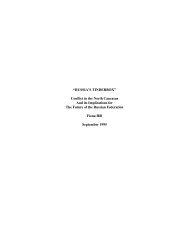Cumulative Deterrence and it's implementations to the War against ...
Cumulative Deterrence and it's implementations to the War against ...
Cumulative Deterrence and it's implementations to the War against ...
You also want an ePaper? Increase the reach of your titles
YUMPU automatically turns print PDFs into web optimized ePapers that Google loves.
use of guerrilla warfare in Vietnam, <strong>the</strong> 1968–70 <strong>War</strong> of Attrition between Egypt <strong>and</strong> Israel<br />
along <strong>the</strong> Suez Canal, <strong>and</strong> Hezbollah’s operational shift <strong>against</strong> Israel following <strong>the</strong> latter’s<br />
pullout from sou<strong>the</strong>rn Lebanon in May 2000.<br />
The cumulative deterrence model, discussed in <strong>the</strong> next section, posits an explanation of<br />
enduring conventional conflicts that do not fit within <strong>the</strong> classical deterrence model for a variety<br />
of reasons. Perhaps <strong>the</strong> most significant reason is that it assumes from <strong>the</strong> beginning that <strong>the</strong>re<br />
will be repeated breaches of <strong>the</strong> first line of security. 9 The model builds on <strong>the</strong> work of George<br />
<strong>and</strong> Smoke, among o<strong>the</strong>rs. 10<br />
CUMULATIVE DETERRENCE<br />
Unlike classical deterrence as practiced during <strong>the</strong> Cold <strong>War</strong>, <strong>and</strong> whose success hinged on a<br />
bipolar st<strong>and</strong>off that held in check any impulse <strong>to</strong> launch a nuclear first strike, cumulative<br />
deterrence is based on <strong>the</strong> simultaneous use of threats <strong>and</strong> military force over <strong>the</strong> course of an<br />
extended conflict. Some scholars argue that such a strategy is not deterrence at all, <strong>and</strong> <strong>the</strong>refore<br />
oppose <strong>the</strong> notion that deterrence can be cumulative. One such scholar is Jack Levy, who<br />
criticizes Zeev Maoz’s methodology for measuring <strong>the</strong> effectiveness of deterrence: “Maoz’s<br />
definition of success <strong>and</strong> failure,” according <strong>to</strong> Levy, “is not appropriate for <strong>the</strong> analysis of <strong>the</strong><br />
success or failure of deterrent threats. A dispute which escalates <strong>to</strong> war is coded as a success for<br />
that side which wins <strong>the</strong> war militarily. This may be useful for <strong>the</strong> <strong>the</strong>oretical questions he is<br />
asking, but from <strong>the</strong> perspective of deterrence, such an outcome should be treated as failure.” 11<br />
Thus, Levy employs <strong>the</strong> same dicho<strong>to</strong>mic criteria for assessing <strong>the</strong> effectiveness of deterrence as<br />
scholars writing about classical deterrence.<br />
Paul Huth <strong>and</strong> Bruce Russett, <strong>the</strong> first scholars <strong>to</strong> offer a definition of long-term, regional<br />
conflict, measure <strong>the</strong> volume of conflict using statistical methods. 12 In <strong>the</strong>ir study, Huth <strong>and</strong><br />
9. Joint Chiefs of Staff, Joint <strong>War</strong>fare of <strong>the</strong> Armed Forces of <strong>the</strong> United States, Joint Doctrine, Caps<strong>to</strong>ne <strong>and</strong><br />
Keys<strong>to</strong>ne Primer, May 30, 1995, p. 1.<br />
10. For more on <strong>the</strong> designing around phenomenon, see Janice Gross Stein, “Calculation, Miscalculation, <strong>and</strong><br />
Convention <strong>Deterrence</strong> I: The View from Cairo,” in Robert Jervis Richard Ned Lebow, <strong>and</strong> Janice Gross Stein,<br />
Psychology <strong>and</strong> <strong>Deterrence</strong> (Baltimore, Md.: Johns Hopkins University Press, 1985), pp. 34–59; <strong>and</strong> Elli<br />
Lieberman, “<strong>Deterrence</strong> Theory: Success or Failure in Arab-Israeli <strong>War</strong>s?” McNair Paper no. 45 (Washing<strong>to</strong>n, D.C.:<br />
National Defense University, Oc<strong>to</strong>ber 1995).<br />
11. Jack S. Levy, “When Do Deterrent Threats Work?” British Journal of Political Science, Oc<strong>to</strong>ber 1988, p. 493.<br />
12. I employed a similar method in Doron Almog, “Israel's <strong>Deterrence</strong> Strategy as a Model for Accumulating<br />
<strong>Deterrence</strong>,” Studies http://www.tau.ac.il/jcss/bulletin/bulletin23-24.pdf. (This work was awarded <strong>the</strong> Tshetshik<br />
Prize for Strategic Studies on Israel's Security from Tel Aviv University's Jaffee Center for Strategic Studies.)<br />
5
















